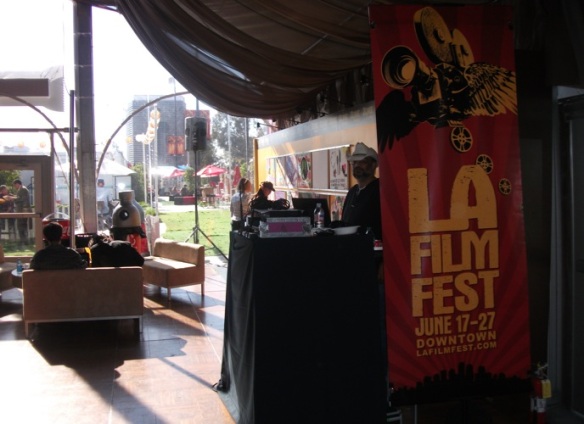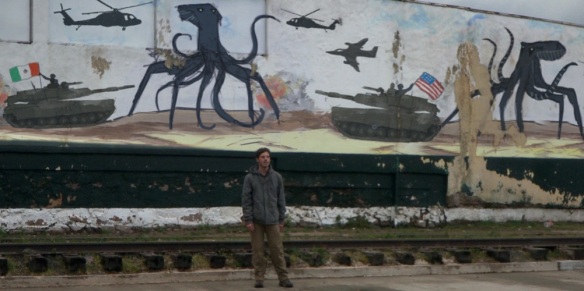Moving a long running event to a new home is always an experiment in tendencies but the ideal seems to have served the Los Angeles Film Festival well in its new home in Downtown LA. Pushing beyond the intensiveness of having the new Twilight movie “Eclipse” premiere at LA Live to great fanfare, the centrality of the Downtown Regal Cinemas seen just off the 110 has its advantages and drawbacks. It does precipitate the population to give Downtown a break beyond its conventions and Laker games. Despite the fact that Westwood has its shortcomings (the biggest being its lack of theaters), there was a warmness to its background while Downtown still requires a little bit of “get-to-know-you”.
The intensive solution rewinds around the Zone Lounge atop the adjacent parking structure where the afternoons offer the presence of folk music and the ever present Coke and Zone pairings while a dexterious amount of filmmakers trying their hands at art as physical manifestation with paint.
The nights bring the Stella and Leblon infused late nights but the reality is that the later progressions of film warrant the extension of life primarily to the theater which, at times, is a big balance of will within the texture.
Two films within this genre structure specifically stood out.
“Monsters“, directed by Gareth Edwards, made its mark as part of the SX Fantastic progression at SxSW. Despite the inevitability of its comparison to “District 9” in reverse, this independently made gem harks in its progression of “War Of The Worlds” (the old school version) and even more so to the dexterity of its filmmaker in terms of the extensive visual effects effectively used. Much of the idea is based around the progress that once you see the creature at the beginning, the question becomes where is it coming from next. This specifically ranged in the Q&A portion after the film. The human structure is simply a framework but, in casting, Edwards specifically used a real life couple, one of which was an actor, and simply puzzleboxed the picture while they were shooting around Guatemala. What it tends to show, in this arena of psuedo-reality filmmaking, is that the audience is more willing to accept what they see with this style than they were simply 4 years ago. While some of the schlepping through the jungle reminds one of “Romancing The Stone”, the boat voyage down a river gives the adequate representation to “Heart Of Darkness” despite an overtly hopefully ending.
“Mandrill“, an action film ode from an opposite angle, knows its boundaries but, with the increasing mobility and structure of the Red, the difference is becoming neglible. While some of the action sequences seem a bit stilted, the actual performance, through in a structure reminiscent of a Latin James Bond, has distinctive pacing and fun within its structure. Like Tarantino, whom the director cited along with Sergio Leone as an influence, the film’s plot is inherently revenge- based and follows a cold hearted assassin who becomes embroiled with a target he is sent to kill. Easy to understand, the high production value and parallel musical intonations with subtle homages to “Saturday Night Fever” including a Latin version of “Manhattan Skyline” really bring the film into focus while creating an identity of its own.
In terms of other movies, there was a touch-and go-tendency inflected in many of the requisite films.
“R”, a hard knox story set in a Danish prison, shows the plight of a petty theft convict who ends up just trying to keep his head above water while biding time. The drama follows a fairly conventional set up but the progression of the lead actor in perceiving his own hope versus the darkness of the men he is imprisoned with becomes a exercise in the greater good where the lowest common denominator wins out.
“Hello Lonesome“, a multi-layered story on the nature of human contact, suffers from many of the shortcomings that plagued Sundance entrant “3 Backyards“. It knows where its structure begins in that of a person alone, a couple trying to find their own identity when tragedy strikes and an older woman trying to recpature a bit of youth through a younger lover. The most effective involves Harry Chase, a real life voice-over artist, because the paradox becomes the ideal driving the plot. The director effectively captures the internal lives his characters are rebelling against despite their best intentions.
“The New Year“, made on a scant budget, follows the sweltering life of a girl on a dead-end track trying to figure out her ultimate move. In a film that could easily be discounted at times because of its meandering plot, the resilience of the lead actress Trieste Kelly Dunn keeps the flair moving at a distinct pace buoyed by a visual and mental style that defies description at times. Like the inner beat poet, Dunn truly seems to capture the generation being profiled without seeming trite or melodramatic, simply real.
“The Wolf Knife“, which like “The New Year” was also shot in Florida, is much more amateurish in its progression. Created more as a study in voyeurism in the psychology of two young women escaping their mundane lives, the mindset more than randomly mirrors the ideology of Harmony Korine. The distinct difference is that director Laurel Nakadate seems inert on the actual plot served more by the dystopian and isolated shots of eyes and faces determining fate than what the girls are actually perceiving. Granted the verite style of the shooting merits a certain perception but ultimately it more ingratiates the story than helps it.
“One Lucky Elephant“, the lone documentary entry seen, revolves around the sanctimonious balance of the majesty of elephants and the life that awaits some in the circus and post-retirement. Discussing the ideology with Director Lisa Leeman and her Writer/Producer Cristina Colissimo, the point inevitably turns to the infinite emotional and psychological aspects of these animals. Having interacted up close on two elephant treks in Thailand, these animals’ personalities are unbounded and, at times, so inherently vibrant that their ultimate mishandling seems more a crime than others. The key, as evidenced in the documentary, is love which David Balding, who brought her to the States to become the star of his circus as a young elephant, lavishes upon her. The inevitable conflict eventually becomes the nature of separation and the inherent (or lack of understanding) of the true motivations inside this elephant’s mind when circumstances create a need for both human and animal to move on.
The Los Angeles Film Festival shows, with a bigger influx of attendees this year, at least on the consumer side, that a change of structure, especially with a city committed to repositioning their downtown area, can be effective. Like its Fall parallel in the AFI Film Festival, this annual fete continues to blossom, not simply by its evolving persona but by a dexterity of programming that both highlights and differentiates.









